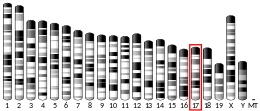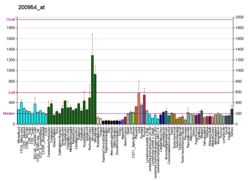ATP6V0C
V-type proton ATPase 16 kDa proteolipid subunit is an enzyme that in humans is encoded by the ATP6V0C gene.[5][6][7]
Function
This gene encodes a component of vacuolar ATPase (V-ATPase), a multisubunit enzyme that mediates acidification of eukaryotic intracellular organelles. V-ATPase dependent organelle acidification is necessary for such intracellular processes as protein sorting, zymogen activation, receptor-mediated endocytosis, and synaptic vesicle proton gradient generation. V-ATPase is composed of a cytosolic V1 domain and a transmembrane V0 domain. The V1 domain consists of three A and three B subunits, two G subunits plus the C, D, E, F, and H subunits. The V1 domain contains the ATP catalytic site. The V0 domain consists of five different subunits: a, c, c', c", and d. Additional isoforms of many of the V1 and V0 subunit proteins are encoded by multiple genes or alternatively spliced transcript variants. This encoded protein is part of the V0 domain. This gene had the previous symbols of ATP6C and ATP6L.[7]
References
- GRCh38: Ensembl release 89: ENSG00000185883 - Ensembl, May 2017
- GRCm38: Ensembl release 89: ENSMUSG00000024121 - Ensembl, May 2017
- "Human PubMed Reference:". National Center for Biotechnology Information, U.S. National Library of Medicine.
- "Mouse PubMed Reference:". National Center for Biotechnology Information, U.S. National Library of Medicine.
- Gillespie GA, Somlo S, Germino GG, Weinstat-Saslow D, Reeders ST (May 1991). "CpG island in the region of an autosomal dominant polycystic kidney disease locus defines the 5' end of a gene encoding a putative proton channel". Proceedings of the National Academy of Sciences of the United States of America. 88 (10): 4289–93. Bibcode:1991PNAS...88.4289G. doi:10.1073/pnas.88.10.4289. PMC 51644. PMID 1709739.
- van Hille B, Vanek M, Richener H, Green JR, Bilbe G (Nov 1993). "Cloning and tissue distribution of subunits C, D, and E of the human vacuolar H(+)-ATPase". Biochemical and Biophysical Research Communications. 197 (1): 15–21. doi:10.1006/bbrc.1993.2434. PMID 8250920.
- "Entrez Gene: ATP6V0C ATPase, H+ transporting, lysosomal 16kDa, V0 subunit c".
External links
- Human ATP6V0C genome location and ATP6V0C gene details page in the UCSC Genome Browser.
Further reading
- Finbow ME, Harrison MA (Jun 1997). "The vacuolar H+-ATPase: a universal proton pump of eukaryotes". The Biochemical Journal. 324 (Pt 3): 697–712. doi:10.1042/bj3240697. PMC 1218484. PMID 9210392.
- Stevens TH, Forgac M (1998). "Structure, function and regulation of the vacuolar (H+)-ATPase". Annual Review of Cell and Developmental Biology. 13: 779–808. doi:10.1146/annurev.cellbio.13.1.779. PMID 9442887.
- Nelson N, Harvey WR (Apr 1999). "Vacuolar and plasma membrane proton-adenosinetriphosphatases". Physiological Reviews. 79 (2): 361–85. doi:10.1152/physrev.1999.79.2.361. PMID 10221984.
- Forgac M (May 1999). "Structure and properties of the vacuolar (H+)-ATPases". The Journal of Biological Chemistry. 274 (19): 12951–4. doi:10.1074/jbc.274.19.12951. PMID 10224039.
- Kane PM (Feb 1999). "Introduction: V-ATPases 1992-1998". Journal of Bioenergetics and Biomembranes. 31 (1): 3–5. doi:10.1023/A:1001884227654. PMID 10340843.
- Wieczorek H, Brown D, Grinstein S, Ehrenfeld J, Harvey WR (Aug 1999). "Animal plasma membrane energization by proton-motive V-ATPases". BioEssays. 21 (8): 637–48. doi:10.1002/(SICI)1521-1878(199908)21:8<637::AID-BIES3>3.0.CO;2-W. PMID 10440860.
- Nishi T, Forgac M (Feb 2002). "The vacuolar (H+)-ATPases--nature's most versatile proton pumps". Nature Reviews Molecular Cell Biology. 3 (2): 94–103. doi:10.1038/nrm729. PMID 11836511.
- Kawasaki-Nishi S, Nishi T, Forgac M (Jun 2003). "Proton translocation driven by ATP hydrolysis in V-ATPases". FEBS Letters. 545 (1): 76–85. doi:10.1016/S0014-5793(03)00396-X. PMID 12788495.
- Morel N (Oct 2003). "Neurotransmitter release: the dark side of the vacuolar-H+ATPase". Biology of the Cell. 95 (7): 453–7. doi:10.1016/S0248-4900(03)00075-3. PMID 14597263.
- Hasebe M, Hanada H, Moriyama Y, Maeda M, Futai M (Mar 1992). "Vacuolar type H(+)-ATPase genes: presence of four genes including pseudogenes for the 16-kDa proteolipid subunit in the human genome". Biochemical and Biophysical Research Communications. 183 (2): 856–63. doi:10.1016/0006-291X(92)90562-Y. PMID 1532310.
- Koralnik IJ, Mulloy JC, Andresson T, Fullen J, Franchini G (Aug 1995). "Mapping of the intermolecular association of human T cell leukaemia/lymphotropic virus type I p12I and the vacuolar H+-ATPase 16 kDa subunit protein" (PDF). The Journal of General Virology. 76 (8): 1909–16. doi:10.1099/0022-1317-76-8-1909. PMID 7636472.
- Laitala-Leinonen T, Howell ML, Dean GE, Väänänen HK (Jan 1996). "Resorption-cycle-dependent polarization of mRNAs for different subunits of V-ATPase in bone-resorbing osteoclasts". Molecular Biology of the Cell. 7 (1): 129–42. doi:10.1091/mbc.7.1.129. PMC 278618. PMID 8741845.





